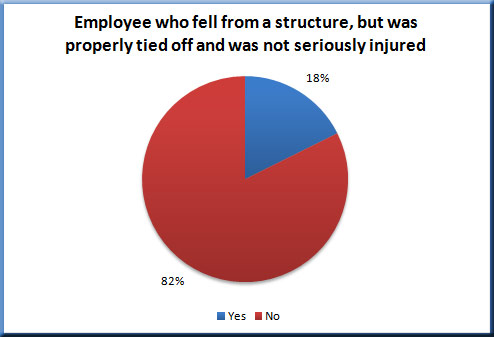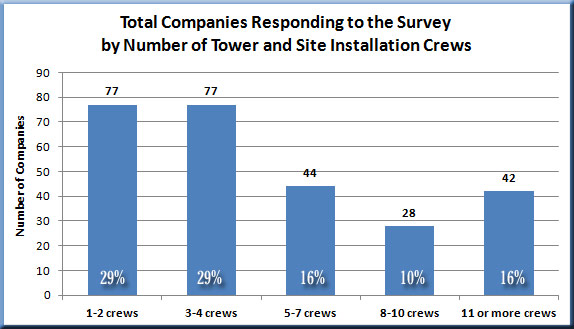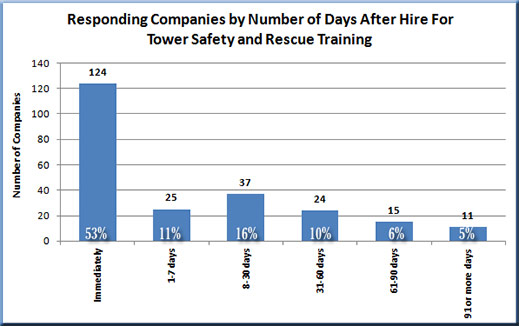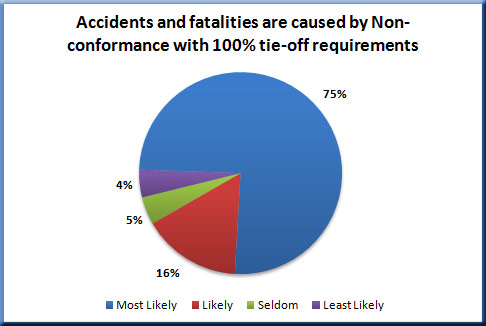According to a comprehensive study released today by WirelessEstimator.com identifying how many wireless technicians routinely work on elevated structures in the course of their employment, the number of tower climbers has dramatically increased to over 29,000 workers, almost triple from the last available analysis undertaken in 2006 by Wireless Estimator which put the total of tower technicians at approximately 9,800.
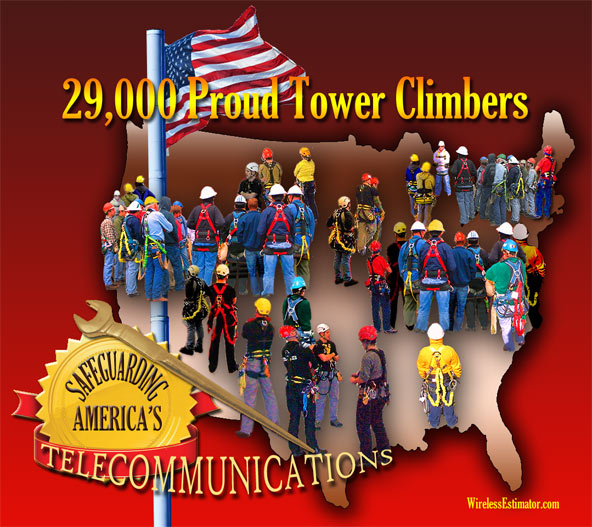
The significant increase comes with a slightly positive upshot for the industry’s safety ranking compared to other high risk professions. Whereas tower construction is often tagged by the media as the most dangerous job in America – and it clearly had been in 2006 – based upon the number of deaths per 100,000 workers used by the Bureau of Labor Statistics for ![]() analysis, the wireless infrastructure industry, reaching an unacceptable 14 deaths in 2013, was the fourth deadliest profession under aircraft pilots and flight engineers.
analysis, the wireless infrastructure industry, reaching an unacceptable 14 deaths in 2013, was the fourth deadliest profession under aircraft pilots and flight engineers.
Here’s how the 29,000 tower climber count was compiled:
In a multi-question survey that was taken between June 2013 and August of 2014, a total of 272 company managers provided the number of crews and tower technicians that they employed that were required to worked on elevated structures.
Using data from the representative number of small, medium and large contractors, it was identifed that the average for each company w as 25.5 tower climbers.
as 25.5 tower climbers.
Utilizing Wireless Estimator’s Blue Book database of 1,145 contractors, a baseline was identified of approximately 29,000 tower climbers.
Two statistical and research analysts that assisted in reviewing the study said the methodology provided an acceptable reference point for an industry that previously relied upon unsupported estimates.
There are, however, some qualifying factors that could modify that total.
When the survey was taken, hiring was at an all-time high to complete 4G build-outs, according to Wireless Estimator’s employment trend lines. In May of 2014, AT&T’s capex spending freeze and a less feverish pitch by other carriers to complete their builds, began a marked decline in hiring, although many companies are still short qualified workers.
Some climbers not included in total
Conversely, the 1,145 contractor-count does not include companies that 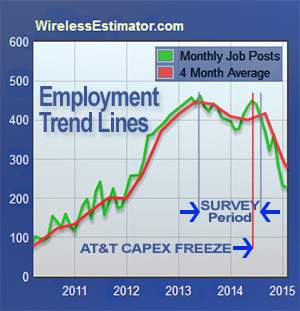 do not have an internet presence, a requirement to maintain accurate data for the Blue Book.
do not have an internet presence, a requirement to maintain accurate data for the Blue Book.
The addition of those companies could raise the 29,000 total 15% to 25% or higher, elevating it to over 36,000 tower climbers.
As a point of reference, 24.8% of the National Association of Tower Erectors contracting companies do not have a web site, a percentage below the national average of small businesses.
In addition, there are a number of climbers who work as 1099 subcontractors with loosely knit crews that are not counted in Wireless Estimator’s research.
Also, an unknown quantity of municipal and utility company tower climbers were not included in the 29,000 estimate.
An individual did not have to work full time on elevated structures, such as a crew foreman to be identified as a tower climber if they were required to be safety trained to climb, and their job description required them to perform those duties as necessary.
Previous counts were mostly guesswork
Trade groups, training companies, federal agencies, insurance actuaries, suppliers and other companies researching and marketing employees who work on elevated structures relied upon anecdotal estimates that oftentimes ranged between 10,000 and 18,000 workers.
In an October presentation in Washington, D.C., Jonathan Adelstein, CEO of PCIA – The Wireless Infrastructure Association, said that an accurate count of tower technicians was difficult to assess since “the number has always remained a moving target”.
National Association of Tower Erectors Executive Director Todd Schlekeway stated that one of the more frequent questions he has fielded over the years has been the total of tower climbers in the nation, and had encouraged his organization and the Wireless Industry Safety Task Force’s members to participate in Wireless Estimator’s 16-month survey.
CTIA has also said that they could not provide any data as to climber resources in the country.
Crew sizes, training requirements and other information is captured in wireless workforce survey |
Companies were contacted to verify the accuracy of their data if it appeared to be in contrast to known averages or industry information.Company surveys and Wireless Estimator research provided additional information below that will be helpful to the industry at large for analysis.
California leads with companies and climbers
California led the nation with the highest number of wireless contractors, 115, with an approximate number of climbers totaling 2,900, followed by Texas, 104 and 2,700; Florida, 95 and 2,400; Georgia, 74 and 1,900; Illinois, 51 and 1,300; and New Jersey; 43 and 1,100.
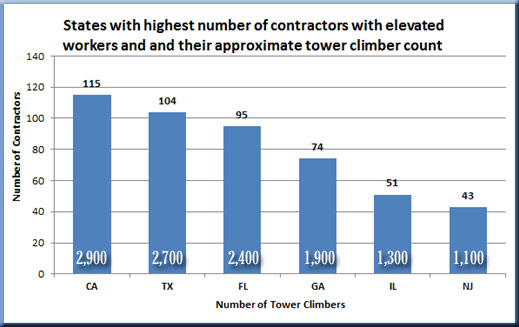
36% of wireless contractors have been in business five years or less
According to the Small Business Administration, 7 out of 10 small businesses (500 employees or less) survive at least 2 years, half at least 5 years, a third at least 10 years, and a quarter stay in business 15 or more years. Wireless contractors appear to mirror the 25% national statistics for companies that have been in business for 15 years or more.
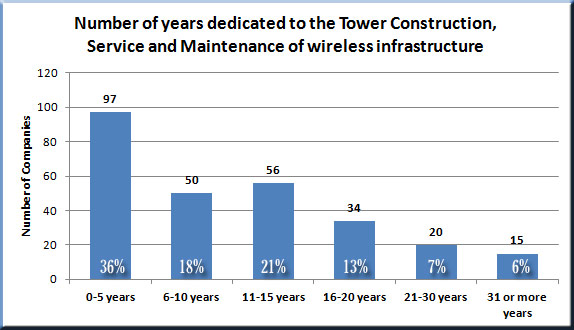
58% of responding companies maintain four crews or less
Responding companies were representative of a cross section of known company sizes. Four elevated workers were used as a baseline for a tower crew in the survey.
53% of contractors provide safety training immediately
In reference to the following question: “How long after you hire a tower climber do you put them through tower safety and rescue training, even if they have been in the industry for a while and were certified with their previous employer?”, 53% of the respondents identified that they were immediately trained. Within a month, 80% of new hires had been trained.
81% of companies have full time safety instructors/personnel
According to survey data, 19% of companies did not have a full time employee dedicated to safety.
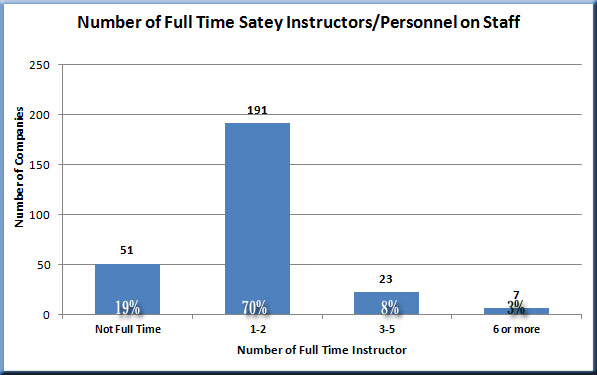
Stringent deadlines are likely causes of accidents and fatalities
Ambitious client deadlines are considered to be a likely reason for accidents and fatalities, according to 47% of the survey’s respondents.
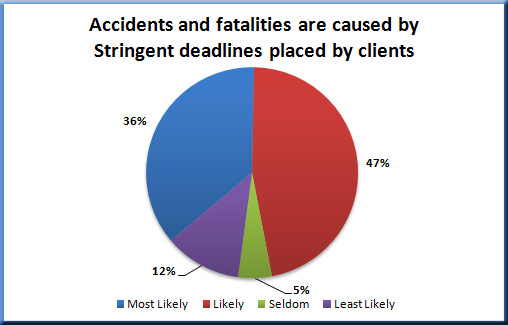
Accidents/Fatalities caused by non-conformance with gin pole standard
16% of respondents said that it was the least likely cause for accidents and fatalities.
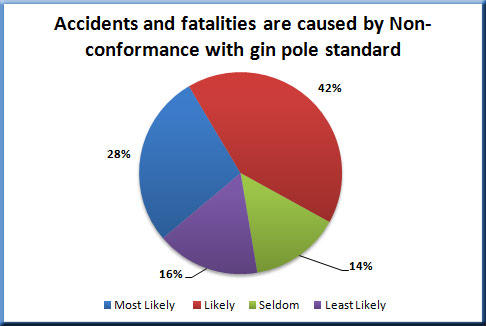
Non-conformance with 100% tie-off is 75% most likely reason for deaths
In line with fatality investigations, OSHA reports and other available information, not being tied off 100% is the primary reason why the industry has a high fatality rate, according to survey data.
Improper use of/or defective safety equipment in fatalities rankings
Respondents were closely split between most likely and likely in reference to whether accidents and fatalities are caused by improper use of/or defective safety equipment.
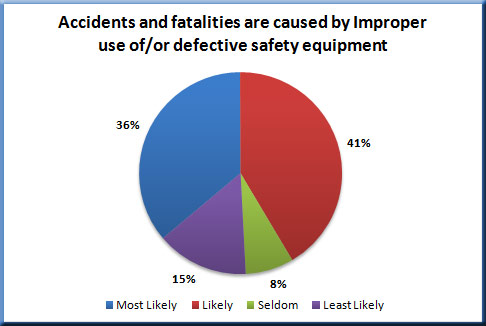
21% presume drug use is the least likely cause of accidents/fatalities
A considerable percentage of respondents, 29%, felt that drugs and substance abuse were the least likely and seldom cause for accidents and fatalities.
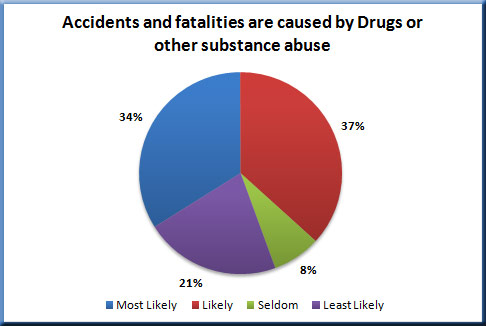
31% believe lack of crane or manbasket availability causes accidents/fatalities
The majority of respondents felt that by not having a manbasket or crane on site that it was seldom or least likely attributable to causing accidents or fatalities.
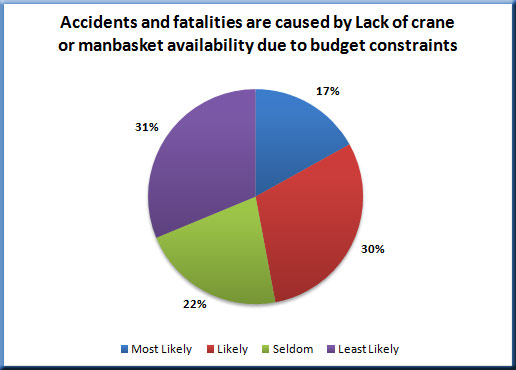
Lack of crane or manbasket seen as least likely probability for accidents
From the below graph, it can be inferred that the companies chose as likely the probability of having any of 5 out of 6 accident types described. For the case of having an accident due to non-conformance with 100% tie-off requirements, the majority chose as most likely to occur if the safety measure is not met. Least likely for accidents or fatalities occurring was if there was a lack of crane or manbasket due to budgetary constraints.
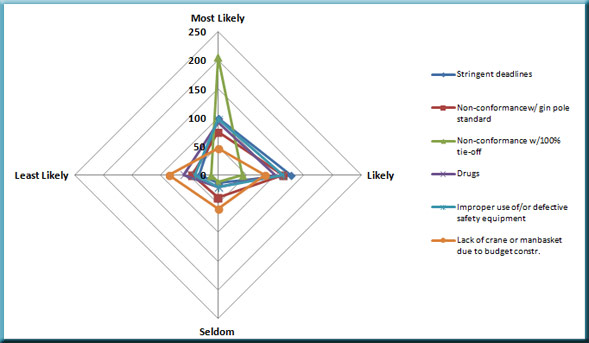
18% had an employee fall from a structure, but was not seriously injured
Survey respondents identified that properly tying off will result in safely returning home to their families.
